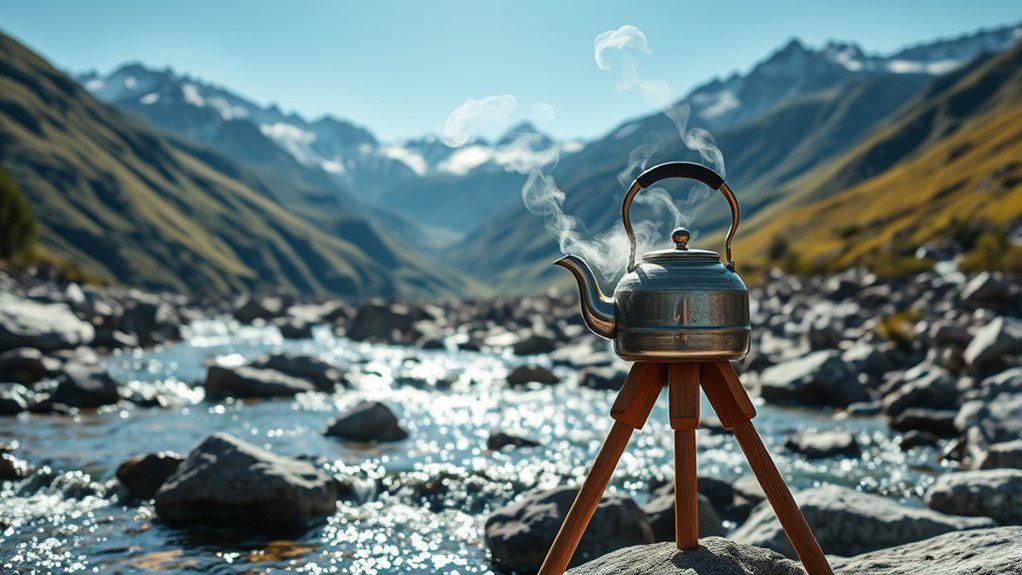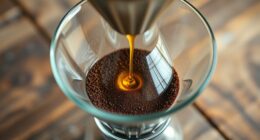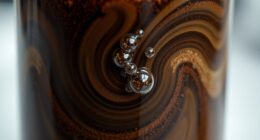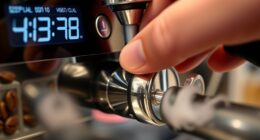At high altitudes, lower boiling points mean your water heats at temperatures below 212°F, which affects extraction and flavor. To compensate, you’ll need longer brew times, finer grind sizes, or adjusted water chemistry to achieve the same flavor quality. You might also tweak your target temperatures slightly higher during infusion. Understanding these changes helps you keep your brews consistent; continue exploring to learn more about optimizing your process in mountain environments.
Key Takeaways
- Higher altitudes lower water’s boiling point, requiring adjustments to brewing temperatures to optimize flavor extraction.
- Reduced boiling temperatures slow flavor release, necessitating longer brew times for full extraction.
- Adjustments in water chemistry, such as mineral additions, help compensate for altitude-related extraction limitations.
- Precise temperature control and extended brewing durations are essential to maintain desired flavor profiles.
- Monitoring and fine-tuning brewing parameters ensure consistent quality despite altitude-induced changes in boiling water.
Understanding How Altitude Affects Water Boiling Points
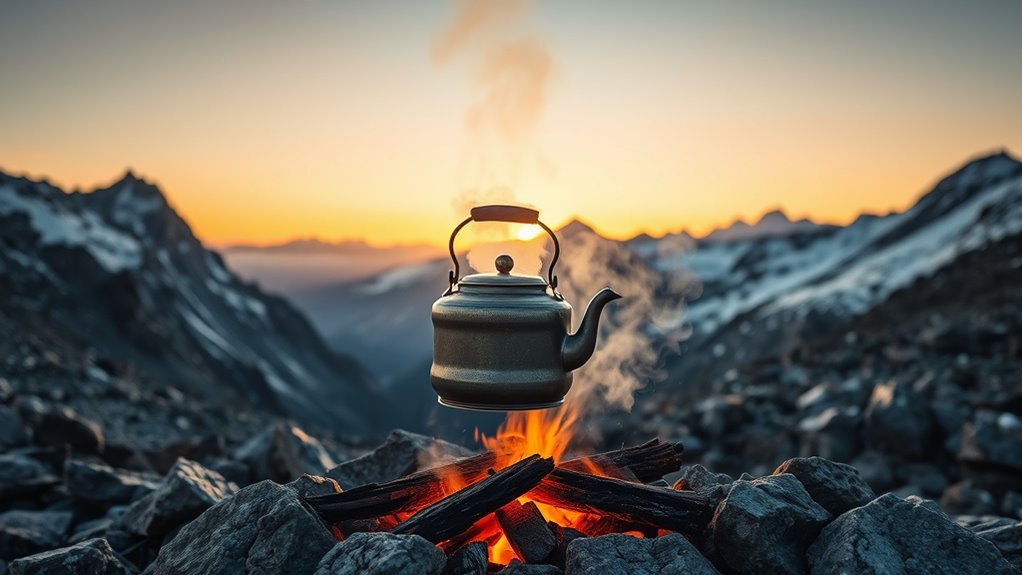
When you ascend to higher altitudes, water doesn’t boil at the familiar 212°F (100°C) anymore. This change is due to altitude effects on water properties. As elevation increases, atmospheric pressure decreases, which lowers the boiling point of water. Instead of boiling at a standard temperature, water will boil at a lower temperature, sometimes notably below 212°F. This shift impacts how water behaves during cooking and brewing, influencing extraction and flavor. Understanding these water property changes helps you adjust your techniques in mountain environments. The altered boiling point is a direct result of reduced pressure, affecting how efficiently heat transfers into the water. Recognizing how altitude affects water properties is essential for achieving consistent results in your brewing process. Additionally, these changes can influence heat transfer efficiency, requiring adjustments to brewing times and techniques.
The Impact of Lower Boiling Temperatures on Coffee and Tea Extraction
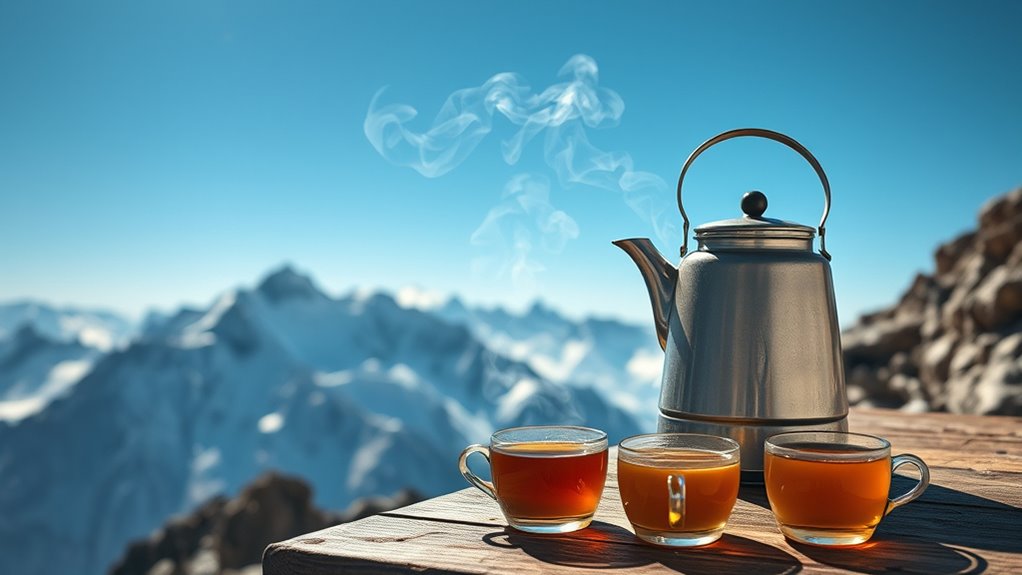
When water boils at lower temperatures, your coffee and tea may not extract as fully, leading to weaker flavors. You might notice your brews take longer to develop, and the taste can shift noticeably. Understanding these changes helps you adjust your brewing process for the best results at high altitudes. Additionally, using specialized indoor gardening tools like self-watering or waterless planters can help maintain consistent moisture levels despite environmental challenges.
Reduced Extraction Efficiency
Lower boiling temperatures at high altitudes can markedly reduce extraction efficiency in both coffee and tea brewing. Altitude effects alter water chemistry, leading to lower boiling points and less effective solubilization of flavor compounds. When water boils at a lower temperature, it can’t extract as many solutes from your coffee grounds or tea leaves, resulting in a weaker brew. This reduced extraction impacts the overall strength and complexity of your beverage. To adapt, you might need to increase brewing time or adjust grind size to compensate for less efficient extraction. Understanding how altitude effects influence water chemistry helps you fine-tune your brewing process, ensuring you still achieve a flavorful cup despite the challenges posed by altitude‑boiled water. Additionally, cognitive function and focus can be affected by the strength of your brew, highlighting the importance of optimizing extraction for both flavor and mental clarity.
Altered Flavor Profiles
Because lower boiling temperatures at high altitudes limit water’s ability to fully extract flavors, the resulting coffee and tea often have altered, less vibrant profiles. Altitude adjustments affect how flavors develop, making some nuances subtle or muted. You might notice a decrease in brightness or a shift in the balance of acidity and bitterness. These flavor nuances are influenced because lower temperatures can prevent the full release of aromatic oils and soluble compounds. As a result, your brews may taste flatter or less complex than expected. To compensate, you might need to tweak your brewing parameters, like increasing brew time or adjusting grind size. Recognizing these flavor profile changes helps you adapt and still enjoy a satisfying cup, even at higher elevations.
Longer Brew Times
At higher altitudes, the reduced boiling temperatures slow down the extraction process, meaning your usual brewing times might not be enough to fully develop the flavors. To adapt, you’ll need longer brew times to compensate for the lower temperature’s impact on water chemistry and extract more solubles from coffee or tea. Altitude adaptation requires adjusting your brewing method, allowing more time for heat transfer and flavor extraction. The altered water chemistry at altitude—less dissolved oxygen and different mineral content—also influences how quickly flavors develop. By extending your brew time, you ensure proper extraction despite the lower boiling point. Incorporating precise temperature control can help optimize extraction, as maintaining the ideal brewing temperature is essential for achieving a balanced, flavorful cup, even when altitude challenges your usual brewing routine.
Adjusting Brewing Times for Mountain Environments
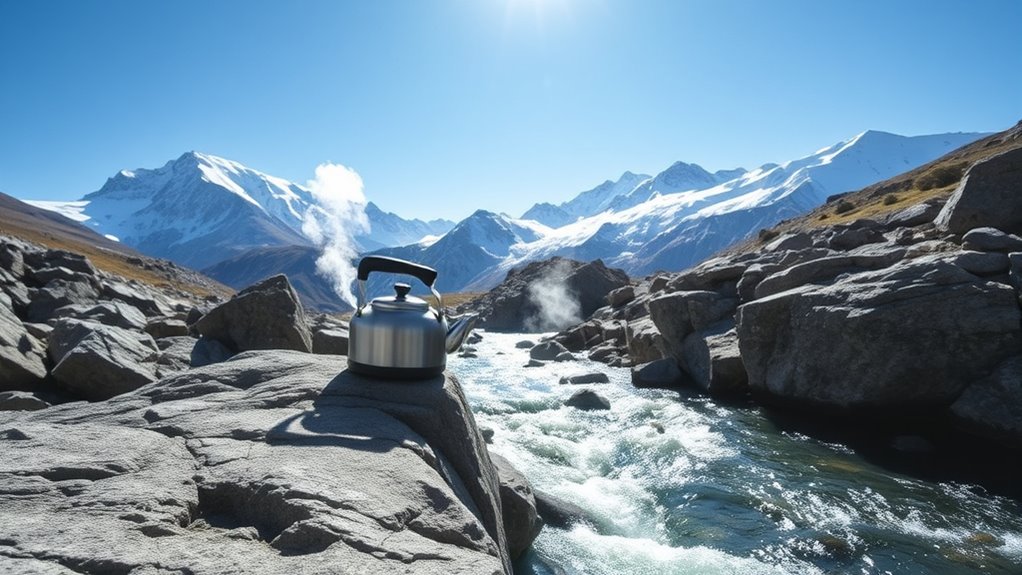
As you brew at higher altitudes, you’ll notice the boiling point drops, affecting how long your coffee or tea needs to steep. To achieve ideal extraction, you might need to extend your brewing times compared to sea level. Adjusting these durations ensures you get the best flavor despite the altitude challenges. Incorporating good lighting can help you better monitor your brew’s progress and prevent over- or under-extraction.
Boiling Point Variations
When brewing at high altitudes, the boiling point of water drops due to decreased atmospheric pressure, meaning your water boils at a temperature lower than 100°C (212°F). This altitude effect modifies water properties, impacting how your brew develops. As the boiling point decreases, heat transfer during brewing becomes less efficient, affecting extraction and flavor. In mountain brewing, understanding boiling point variations helps you adjust your process to compensate for these changes. You might need longer boiling times or higher temperatures to achieve the desired extraction levels. Recognizing how altitude influences boiling point ensures you can maintain consistent quality, despite the challenges of mountain environments. By considering these boiling point variations, you optimize your brewing targets for the best possible results at altitude.
Brewing Duration Adjustments
Adjusting brewing times becomes necessary because the lower boiling point at high altitudes affects how heat transfers during the process. To ensure proper extraction and flavor, you need to modify your brewing duration, considering altitude adaptation and water chemistry. Longer steeping times may be required to compensate for the reduced boiling temperature, ensuring flavors fully develop. Additionally, understanding Italian espresso techniques can help optimize results in mountain environments. Here’s a quick guide:
| Altitude (ft) | Recommended Brew Time | Water Chemistry Adjustment |
|---|---|---|
| 0-2,000 | Standard | No change |
| 2,000-4,000 | +30 seconds | Slight increase |
| 4,000-6,000 | +1 minute | Moderate increase |
| 6,000-8,000 | +1.5 minutes | Significant adjustment |
| 8,000+ | +2 minutes or more | Major water chemistry tweaks |
This table helps you adapt brewing duration and water chemistry for consistent results in mountain environments.
Modifying Temperature Targets for Optimal Flavor at High Elevations
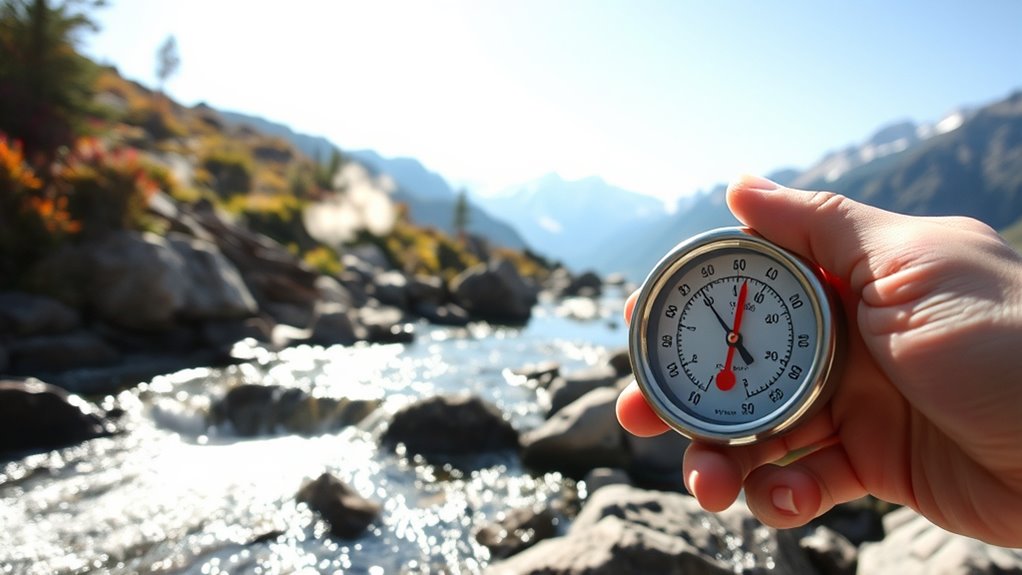
At high elevations, the lower boiling point of water means you need to modify your brewing temperature targets to achieve ideal flavor. Altitude adaptation involves adjusting your temperatures to compensate for reduced water boiling points, ensuring proper extraction of flavors. Since water boils below 100°C, maintaining your usual brew temperatures may lead to under-extraction, resulting in weaker or less developed flavors. To optimize flavor, aim for slightly higher temperatures than standard recipes suggest—around 2–4°C more—while monitoring for over-extraction. This adjustment helps balance extraction rates, preserving the desired aroma and taste profiles. By modifying your temperature targets thoughtfully, you can achieve flavor optimization despite the challenges posed by high-altitude brewing.
Techniques to Compensate for Reduced Boiling Temperatures

To effectively compensate for reduced boiling temperatures at high elevations, you can employ specific brewing techniques that enhance extraction despite the lower water temperature. Altitude adaptation involves adjusting your process to maintain flavor. Here are four effective methods:
- Increase steeping times to allow more extraction from grains and hops.
- Use finer grind sizes to improve surface area and water contact.
- Add extra malt or fermentable sugars to compensate for less efficient extraction.
- Slightly raise water temperature during infusion steps when possible, without exceeding safe limits.
- Monitor and adjust your brewing times based on altitude impacts to ensure consistent results.
These techniques help offset altitude-related water temperature drops, ensuring your brew maintains its intended flavor profile. By adapting your approach, you optimize extraction and achieve consistent results despite the challenges of high-altitude brewing.
Equipment Considerations for Mountain Brewing
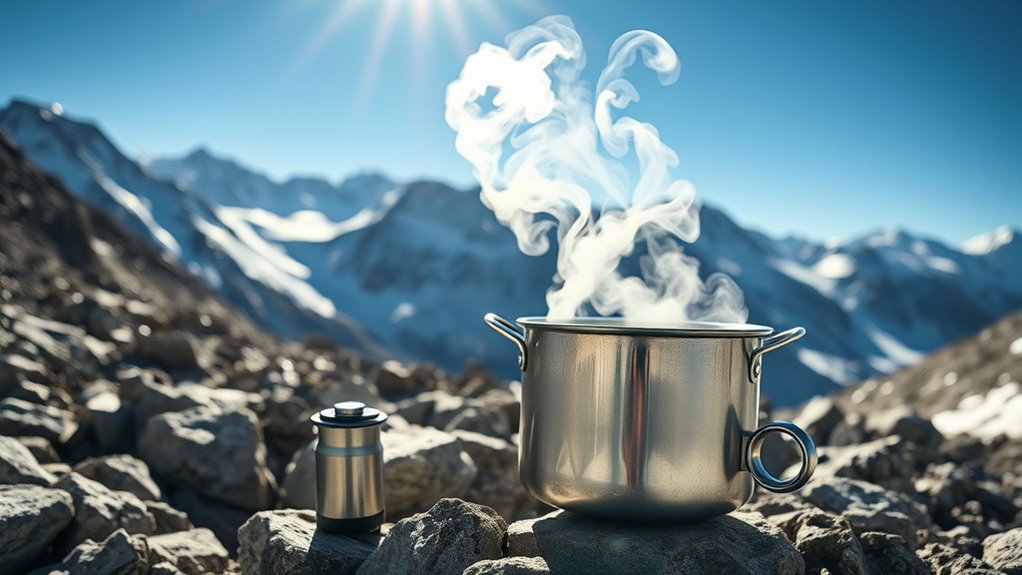
When brewing in mountain environments, selecting the right equipment is vital to overcoming altitude-related challenges. Standard brewing gear may not perform well at high elevations, so consider altitude equipment designed for these conditions. Mountain filters are indispensable for removing impurities from mountain water sources, guaranteeing clean brewing water. Use durable, high-quality kettles that withstand fluctuating temperatures and reduced boiling points. An accurate thermometer helps you monitor water temperature precisely. Adjust your brewing system to compensate for lower atmospheric pressure, and consider pressure-rated equipment for safety. Here’s a quick overview:
| Equipment Type | Purpose |
|---|---|
| Mountain filters | Purify mountain water |
| Altitude kettles | Handle temperature fluctuations |
| Thermometers | Guarantee precise temperature control |
| Pressure cookers | Compensate for boiling point reduction |
| Safety valves | Prevent pressure buildup |
Practical Tips for Achieving Consistent Results in High Altitudes

Achieving consistent brewing results at high altitudes requires attention to detail and careful adjustments. To master altitude adaptation, focus on controlling water chemistry, as altitude affects boiling points and mineral balances. Here are four practical tips:
- Adjust your water chemistry by adding minerals to compensate for altitude-induced changes.
- Use a reliable thermometer to monitor water temperature accurately during brewing.
- Modify your recipe’s water volume to account for increased evaporation rates.
- Experiment with brewing times to find the most favorable extraction, considering altitude effects on boiling and steeping.
Experimenting and Fine-Tuning Your Brewing Process in Mountain Settings
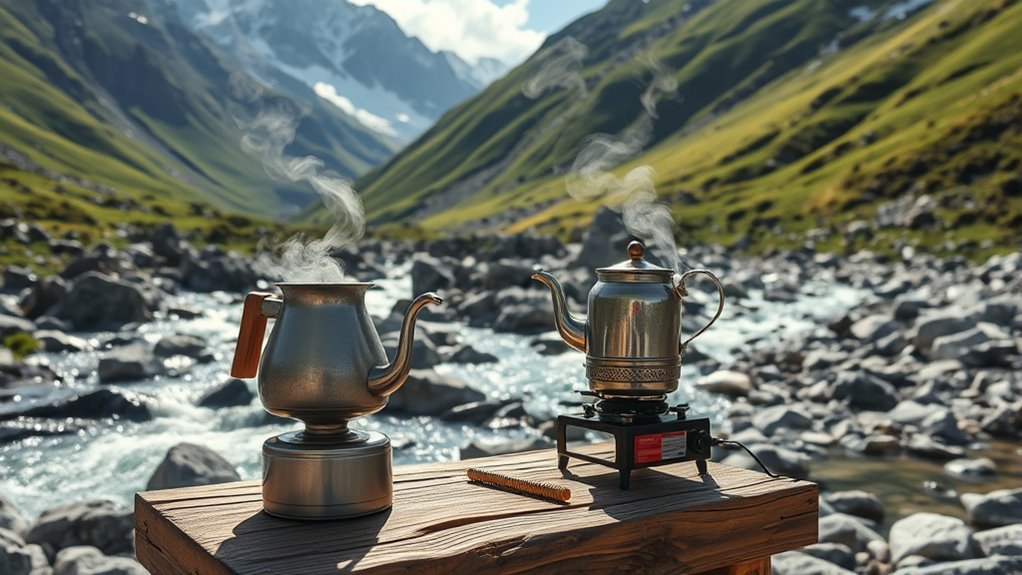
Mountain brewing often requires adjustments and experimentation to find the perfect balance, as altitude impacts water boiling points, extraction rates, and flavor development. Altitude challenges can alter water chemistry, affecting how your ingredients interact during brewing. To fine-tune your process, start by monitoring how water behaves at your elevation—adjust your target temperatures and brewing times accordingly. Experiment with different grist ratios and hop additions, observing how these changes influence flavor extraction. Keep detailed notes on each batch to identify patterns and ideal adjustments. You may need to modify your water chemistry by adding minerals or acids to enhance flavor and improve extraction. Regular testing and iterative tweaks will help you overcome altitude challenges and produce consistently great beer in mountain settings.
Frequently Asked Questions
How Does Altitude Affect Water Mineral Content During Boiling?
Altitude effects influence water mineral content during boiling by causing minerals to become more concentrated. As you boil water at higher elevations, the lower boiling point accelerates evaporation, leaving behind minerals and increasing their concentration. This change impacts water’s mineral profile, affecting taste and brewing processes. You’ll notice that at higher altitudes, mineral concentration rises, so adjusting brewing targets is essential to achieve consistent flavors and quality in your beer.
Can Different Brewing Methods Respond Uniquely to High-Altitude Boiling?
Did you know that some brewing methods respond more effectively to high-altitude boiling? For example, using specialized brewing equipment like pressure cookers can help preserve flavor by controlling temperature and pressure better. High-altitude boiling can alter water’s mineral content, impacting flavor preservation. You might need to adjust your brewing targets and techniques to guarantee your brew maintains its intended taste, especially when working with different brewing methods in mountain conditions.
Are There Specific Types of Coffee or Tea Better Suited for Mountain Brewing?
You’ll find that mountain-grown beans and high-altitude teas often excel in mountain brewing. These products develop unique flavors due to their growth environment, making them well-suited for high-altitude brewing. You’ll notice that mountain-grown beans offer richer, more complex profiles, while high-altitude teas tend to be more delicate and nuanced. So, for the best experience, choose these types of coffee and tea when brewing in the mountains.
How Do Ambient Temperature and Humidity Influence High-Altitude Brewing Outcomes?
Imagine your brewing journey as a dance with nature’s subtle shifts. Humidity impact and temperature variation in high altitudes gently sway your results. Lower temperatures can slow extraction, making brews lighter, while high humidity might cloud clarity or dilute flavors. You’ll need to adapt your timing and techniques, embracing these atmospheric nuances. By staying attentive to these factors, you can craft a balanced, flavorful cup despite the mountain’s changing environment.
What Safety Considerations Are Needed When Boiling Water at High Elevations?
When boiling water at high elevations, altitude safety is essential to prevent boiling hazards. You should be aware that water boils at lower temperatures, which can lead to prolonged boiling times or unexpected splashes. Always use proper equipment, avoid overfilling pots, and stay attentive to prevent burns or spills. Recognizing boiling hazards and practicing safe handling guarantees you stay safe while managing altitude-specific challenges in your brewing process.
Conclusion
Think of mountain brewing like tending a delicate fire in a windy forest. Just as you’d adjust your flames to keep the fire alive, you need to tweak your water’s temperature and timing to access the best flavors at high altitudes. Embrace these changes as part of your journey, turning each brew into a unique adventure. With patience and experimentation, you’ll master the art of mountain brewing, transforming challenges into rewarding flavors.
